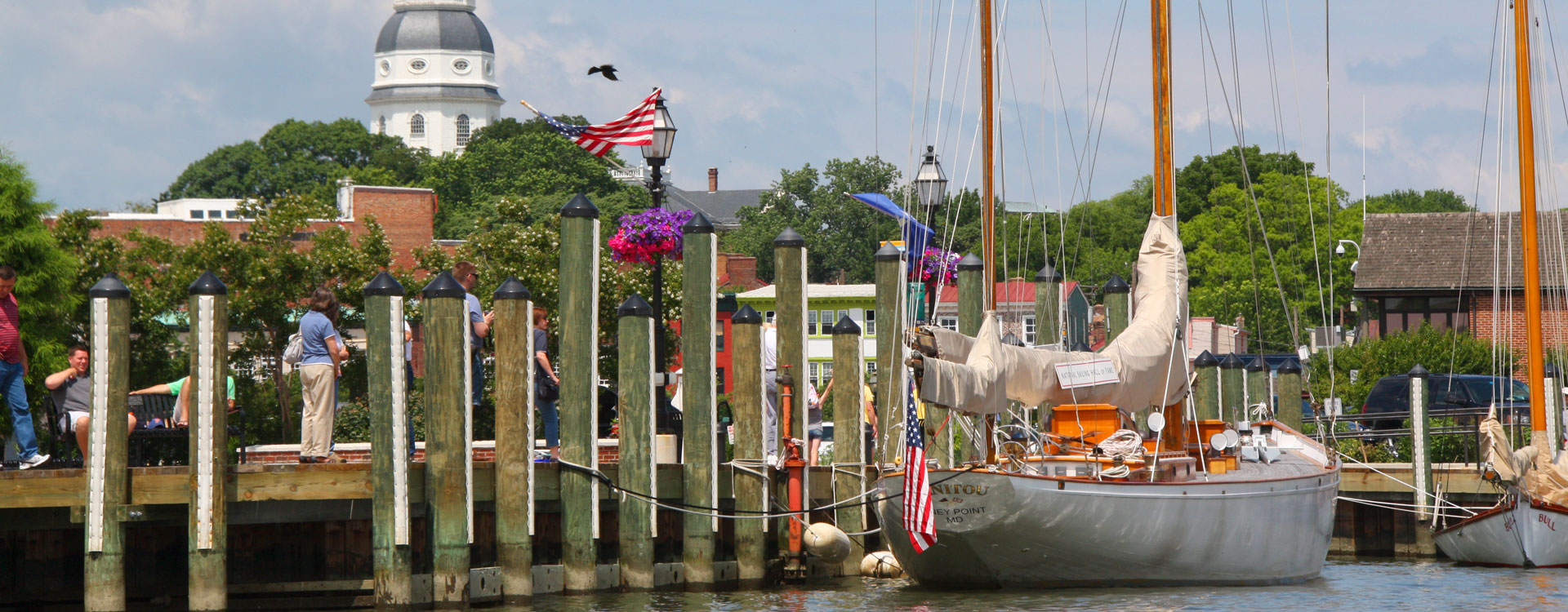Illustrious Past — Opportune Future

Annapolis’ combination of rich history and maritime charm make it an appealing place to live and the perfect destination for visitors. Businesses could not make a better choice.
“Annapolis is indeed a special and unique place. Come thrive in our city.”
Centuries of Success
Annapolis is a compact city with 7.2 square miles of land enhanced by 17 miles of spectacular waterfront along the Chesapeake Bay and its tributaries. Planned, designed and built as a Capital City over three hundred years ago, the golden threads of Annapolis’ heritage: government, education, maritime, hospitality, and leisure industries, continue to prosper today. In addition, a vibrant mix of technology, retail, professional and healthcare services has added a wealth of diversity to the City’s economic vitality.
Diverse Opportunities
Building upon an illustrious past, Annapolitans have carefully cultivated a highly desirable quality of life and an exciting future. Through historic preservation and careful planning in neighborhoods that span the centuries, the City offers a unique small-town quality of life with historical and maritime charm, yet also provides big-City style and modern amenities. From the brick-lined streets of the Historic District, to state-of-the-art developments, there are facilities to accommodate almost any enterprise and preference.
Easy Access
Annapolis’ reach extends beyond city limits, attracting businesses from around the globe. Many companies, varying widely in size and industry focus, have chosen to locate in this busy hub that is situated within 35 miles of Washington DC, and Baltimore MD, with excellent highway systems connecting to both cities. Proximity and easy access to three major airports, including Baltimore/Washington International Thurgood Marshall Airport, as well as the Port of Baltimore make Annapolis a small city with major amenities and global reach.
Regal Foundation
Capital Worthy of a Queen
Instead of using a customary grid for Annapolis, former Maryland Governor Sir Francis Nicholson constructed a baroque plan similar to the magnificent capitals of Europe. He chose to honor Princess Anne, heir to the throne, and in 1708, as Queen, she chartered her colonial namesake as a city. Her royal badge, with a crown over the entwined thistle of Scotland and Tudor rose of England, is depicted on the Annapolis flag.
Magnificent European Plan
Circles with radiating streets create focal points and give importance to certain structures. St Anne’s, the Episcopal Church, sits in one prominent downtown circle and watching over the City in the other, is the State House, the seat of government and the oldest such capital building in continuous use in the United States. This urban design was admired by frequent visitor George Washington, who later had Pierre L’Enfant incorporate it into the nation’s capital.
Delightful Human-Scale
The result is a delightful human-scale City, making it easy to walk to many attractions, including the United States Naval Academy and St. John’s College (the third oldest college in the United States), right in the Historic District. A pleasant stroll along tree-lined streets will take you to the harbor, museums, art galleries, restaurants and wonderful shops.
Influential History
Seat of Power
The capital of Maryland was the nation’s capital when the Treaty of Paris, ending the Revolutionary War, was signed in the City. As it was from the beginning of our nation, Annapolis remains the hub of government activity and today, is the county seat of Anne Arundel County, and Maryland’s capital. The same State House where George Washington tendered his resignation as General of the Continental Army following the Revolutionary War is still charged with energy during the three months every year when the Maryland General Assembly meets in its chambers.
Magnificent Attractions
Annapolis has great historical significance for other reasons too. All four Maryland signers of the Declaration of Independence had impressive homes in Annapolis, which still stand. Prosperous merchants built mansions that would rival any in England, many with ballrooms and formal gardens where lavish social functions occurred. Today, Annapolis has more original 18th-century structures standing than any other city in the United States and their beauty and architectural style have made them a major attraction.
Deep Waterfront Connection
Strong Maritime Community
In its early days, a thriving shipping industry brought great wealth to Annapolis. The Chesapeake Bay still plays a major role in commerce, although today the City is more of a recreational boating, fishing, sailing and racing hub than shipping. Supply and service establishments dot the shoreline and comprise a vigorous maritime industry. Annapolis has always been a very popular port of call for international sailors, who consider the city “America’s Sailing Capital.” Every fall, the largest in-the-water boat shows in the world are held on successive weekends for sail and power enthusiasts respectively.
Illustrious Naval Heritage
Annapolis is also home to the United States Naval Academy, the second oldest of the five federal service academies. Students, known as midshipmen, are on active duty in the U.S. Navy while they are educated and trained as future officers of competence, character, and compassion. Upon graduation, they serve in the U.S. Navy or Marine Corps. The lush and scenic grounds of the campus, known as the “Yard,” combine the beauty of Beaux Arts architecture and historical monuments commemorating the bravery and heroism that are an inherent part of the Academy’s naval heritage, with state-of-the-art technology that exemplifies today’s Navy and Marine Corps.
Gracious Hospitality and Rich Culture
Wealth of Inspiration
From its earliest days as a colonial capital city, Annapolis was known as the “Athens of America” due to its wealth of cultural activities, a glittering social season, gracious hospitality and intellectual stimulation. More than 300 years of welcoming visitors has made our hospitality second to none. You will find the same welcoming atmosphere today, drawing more than 4 million people a year to the City’s shores.
Famous Specialty Cuisine
The small colonial seaport brought visitors from around the world who shared the news of the day while enjoying the ambiance and exquisite Tidewater cuisine of the local pubs. The same cuisine appreciated then is still a major part of Annapolis hospitality. The many pubs and restaurants in town, including some that date back to the 18th century, offer Maryland seafood specialties from the Chesapeake Bay. Many also offer buy-local and farm-to-table menus that spotlight delicacies from the City’s and surrounding farms, wineries, craft brewers and culinary artists.
Legendary Arts and Culture
The arts also abounded in colonial Annapolis, as performers, skilled artisans, and artists practiced their trades, including the Peale family, noted portraitists, and John Shaw, a cabinetmaker who designed quality furniture and was responsible for much of the construction of the Maryland State House. Annapolis also featured the first theater in the new world. You will find that same appreciation for the cultural arts in Annapolis today and the City remains a thriving center for studying, exhibiting, performing, and practicing the visual and performing arts. Whether you prefer Shakespeare or the Fringe Festival, listening to the symphony or to local songwriters, Annapolis offers a wide range of world-class performing arts and music at theaters, galleries, events and festivals throughout the City.
Come Thrive in Annapolis
Excellent and Diverse Marketplace
Annapolis has been welcoming visitors for more than 300 years, and it remains a wonderful place to live, raise a family, work and establish a business. An estimated 4 million visitors annually indulge in our historic architecture, world-renowned cuisine, thriving maritime amenities and diverse cultural arts activities. Whether you come for the history, education, water or hospitality, there is always something happening in Annapolis for you to enjoy. In addition to providing a highly desirable quality of life for every type of business and its workforce, these rich dimensions make Annapolis an excellent marketplace for businesses and entrepreneurs to offer goods and services of all descriptions.
